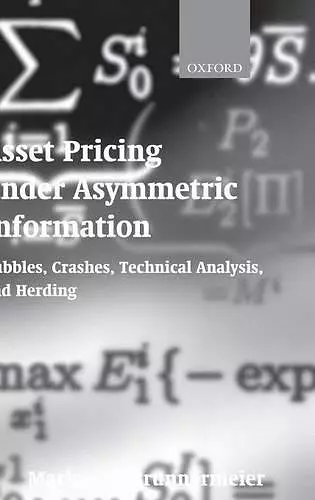Asset Pricing under Asymmetric Information
Bubbles, Crashes, Technical Analysis, and Herding
Format:Hardback
Publisher:Oxford University Press
Published:25th Jan '01
Currently unavailable, and unfortunately no date known when it will be back

Asset prices are driven by public news and information that is often dispersed among many market participants. These agents try to infer each other's information by analyzing price processes. In the past two decades, theoretical research in financial economics has significantly advanced our understanding of the informational aspects of price processes. This book provides a detailed and up-to-date survey of this important body of literature. The book begins by demonstrating how to model asymmetric information and higher-order knowledge. It then contrasts competitive and strategic equilibrium concepts under asymmetric information. It also illustrates the dependence of information efficiency and allocative efficiency on the security structure and the linkage between both efficiency concepts. No-Trade theorems and market breakdowns due to asymmetric information are then explained, and the existence of bubbles under symmetric and asymmetric information is investigated. The remainder of the survey is devoted to contrasting different market microstructure models that demonstrate how asymmetric information affects asset prices and traders' information , which provide a theoretical explanation for technical analysis and illustrate why some investors "chase the trend." The reader is then introduced to herding models and informational cascades, which can arise in a setting where agents' decision-making is sequential. The insights derived from herding models are used to provide rational explanations for stock market crashes. Models in which all traders are induced to search for the same piece of information are then presented to provide a deeper insight into Keynes' comparison of the stock market with a beauty contest. The book concludes with a brief summary of bank runs and their connection to financial crises.
This book develops the conceptual foundations required for the analysis of markets with asymmetric information, and uses them to provide a clear survey and synthesis of the theoretical literature on bubbles, market microstructure, crashes, and herding in financial markets. The book is not only useful to the beginner who requires a guide through the rapidly developing literature, but provides insight and perspective that the expert will also appreciate. Michael Brennan, Irwin and Goldyne Hearsh Professor of Banking and Finance at the University of California, Los Angeles, and Professor of Finance at the London Business School. President of the American Finance Association, 1989
This book provides an excellent account of how bubbles and crashes and various other phenomena can occur. Traditional asset pricing theories have assumed symmetric information. Including asymmetric information radically alters the results that are obtained. The author takes a complex subject and presents it in a clear and concise manner. I strongly recommend it for anybody seriously interested in the theory of asset pricing. Franklin Allen, Nippon Life Professor of Finance and Economics at the Wharton School, University of Pennsylvannia, and President of the American Finance Association, 2000
This timely book provides an invaluable map for students and researchers navigating the literature on market microstructure, and more generally, on equilibrium with asymmetric information. It will become highly recommended reading for graduate courses in the economics of uncertainty and in financial economics. Hyun Song Shin, Professor of Finance at the London School of Economicsr
ISBN: 9780198296980
Dimensions: 241mm x 161mm x 19mm
Weight: 548g
262 pages